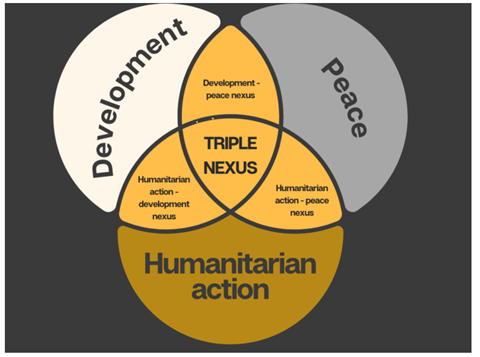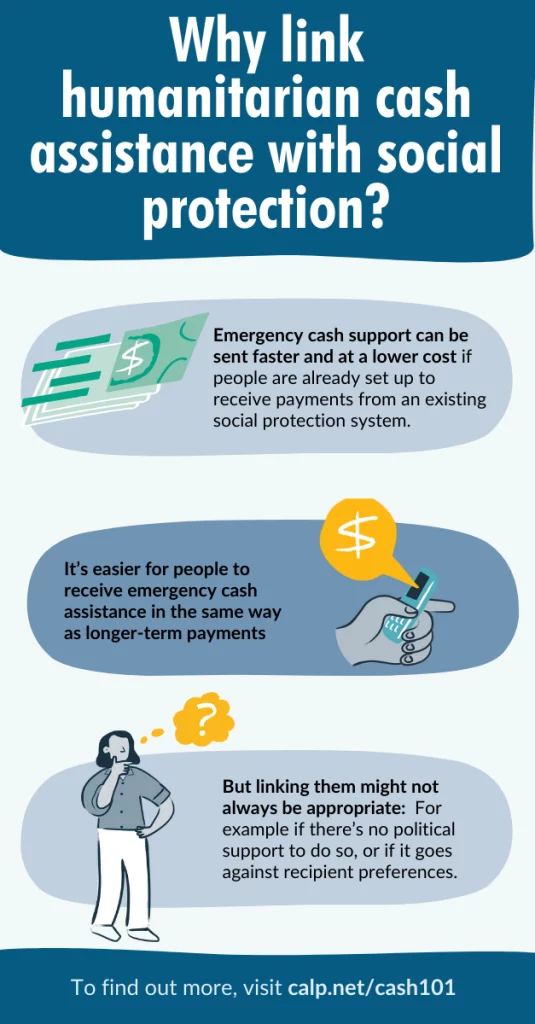CVA and Development Programmes

Cash and Voucher Assistance (CVA) and links with longer term development
As crises around the world become more protected, the need to better link humanitarian and development work is increasingly necessary.
CVA can link emergency assistance to longer-term development, especially through social protection systems.
Examples of how humanitarian CVA can link to longer-term development:
- Humanitarian CVA can be provided to scale up support for vulnerable communities through existing government safety net systems.
- Humanitarian CVA can support community groups to invest in small businesses
- Humanitarian CVA can increase spending by disaster affected communities, contributing to the local economy and boosting the local businesses.
The Humanitarian-Development Nexus
Humanitarian and development professionals often talk about the ‘humanitarian-development nexus’; – this refers to how humanitarian and development programmes can operate together in a complementary way to respond to people’s short-term needs, as well as their longer-term vulnerabilities.

As CVA is used in both humanitarian and development contexts, it can act as a bridge for the humanitarian-development nexus. CVA can simultaneously provide immediate cash for basic needs to people impacted by a disaster and support initiatives that help build resilience.
For example, CVA is used in Oxfam’s triple nexus programming, which aims to address the underlying drivers of conflict and its root causes. Its’ Emergency Food Security and Vulnerable Livelihoods work uses cash transfers to cover immediate basic needs, and is paired with longer-term temporary employment to build economic resilience.
Find out more on the humanitarian-development nexus page on the Cash 101.
Why would you use CVA in a development context?
Humanitarian CVA can be a useful tool to use in a development context and can provide help for vulnerable people in areas prone to shocks. For example, a one-off emergency cash transfer could be sent to a family already supported by a development programme during an acute drought.
CVA could be used within a development context in order to:
- Reduce debt and promote new livelihood strategies.
- Support community and market recovery, social cohesion and livelihoods.
- Provide increased and predictable access to basic services and needs.
- Support vulnerable families who were hit hardest by the emergency or those who are vulnerable to crisis over the longer term.
- Develop linkages to social protection systems.
One examples of CVA being used within a development context is a programme by GiveDirectly which provided a $1000 cash transfer to refugees in the Kiryandongo settlement in Uganda. Two years later significant positive impacts were observed. The households that received the funds showed increased spending by $32 USD per month on goods and services. Asset ownership among recipient households increased by 61%, with families investing in assets such as land and home improvements. Overall, the cash transfer program showed promising outcomes in supporting refugees to grow their assets and income while improving their well-being in the protracted displacement context. Watch GiveDirectly’s video about the programme “Not everyone wants a goat”.
What are social protection systems?
‘Social Protection Systems’ are a set of policies and programmes aimed at preventing or protecting people against poverty, vulnerability and social exclusion. They are normally run by governments, and may include, for example, financial support for people with disabilities; those caring for orphans; or those who have long term illnesses. In unstable contexts such as conflict, assistance from humanitarian non-state actors can sometimes resemble social protection systems.
How does cash and voucher assistance link to social protection systems?
Linkages between social protection systems and CVA is not a new topic and has a long history and shifting terminology – from ‘relief to development’, ‘the continuum’, ‘resilience’ and most recently ‘the nexus’.
The increase in long-term and recurrent crises means humanitarians need to look for more effective, efficient and sustainable ways to support people affected by crises. Linking humanitarian response with social protection systems can help communities build longer-term resilience and recover more quickly from crises. It can also reinforce, complement and avoid programme duplication.
What are the benefits of linking humanitarian CVA with social protection?
- Speed: Linking CVA with established social protection systems can increase the speed of sending emergency CVA to people in need.
- Reduce duplication: Humanitarian actors can make use of existing systems, instead of setting up parallel structures when delivering aid during a crisis.
- Stability: Allows people to build resilience through regular and predictable support while providing additional resources when disasters occur.
- Holistic approach: People affected by a crisis only need to interact with one system that provides both longer-term support and emergency aid, designed to work together.
- Build capacity: When appropriate, humanitarian CVA can contribute to state-run social protection systems and help strengthen their capacity.

There are also a number of challenges to be addressed when linking humanitarian CVA to social protection, such as:
- A lack of coordination between the actors involved,
- Social protection systems are not usually designed to respond to crises,
- Social protections systems can exclude key groups of vulnerable people such as refugees,
- Humanitarian practitioners often lack expertise in social protection.
Read more about Social Protection on the Cash 101, or keep up to date with the latest developments with CALP’s Social Protection team and community of practice.
Learn more about linking humanitarian CVA and social protection with CALP’s Social Protection Toolbox.